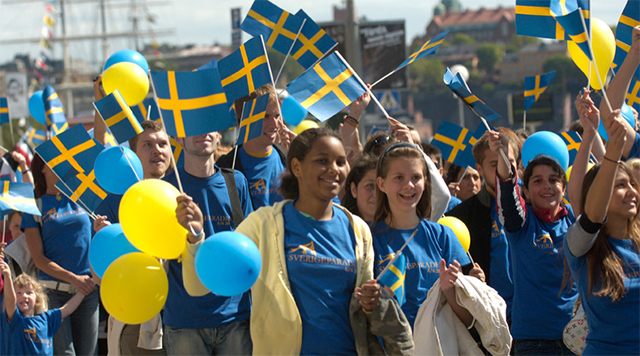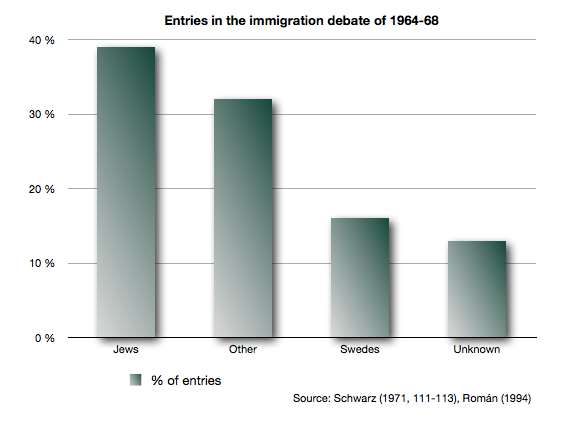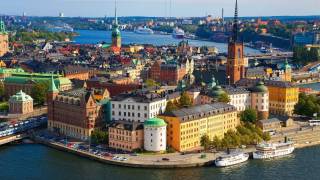How and why Sweden became multicultural
Source: destroyzionism.com

No one can deny that multiculturalism and mass immigration are a reality in Sweden today. However, it hasn’t always been so. As late as 1965, the social democratic Prime Minister of Sweden Tage Erlander said: “We Swedes live in an infinitely luckier situation. Our country’s population is homogeneous, not only in terms of race, but also in many other respects.” The demographic transformation of Sweden did not just happen to happen. It was a direct result of political decisions, which in turn could be undertaken because of some actor’s conscious agenda and very active advocacy in the 1960s and 1970s. Earlier, Sweden had an approach towards immigrants and ethnic minorities that was based either on expulsion or assimilation. Immigrants who were ethnically and culturally closely related would assimilate while non-European immigrants, Gypsies and Sami would be excluded from the community. Now, however, suddenly a new approach prevailed: Sweden would become a pluralistic multicultural society and the multicultural paradigm would become the overall goal of Swedish culture, politics and society.
In 1930, 1 percent of the population in Sweden was born in a foreign country and the vast majority of them came from other northern European countries. During the 1950’s and 1960’s there was a relatively large labor immigration from other European countries. Many of these immigrants returned home after service in Sweden and those who remained were mostly assimilated without major problems. In 2000, Sweden’s total population was slightly more than 8.8 million of which one million was foreign born. A fifth of the total population had at least one parent born outside of Sweden of which 547,907 people had at least one parent born outside of Europe and U.S. (Source: Statistics Sweden). In 2011, 93,134 people were granted residence and during the whole period 1980-2011 the figure was 1,529,666 (source: The Swedish Migration Board), of which approximately one million came from non-Western countries (see previous source and add to family reunification). Ethnic Swedes are expected to be a minority in Sweden before 2050 if immigration continues at the same rate.
According to Tomas Hammar’s (et al.) comparative study European Immigration Policy (Cambridge University Press, 1985) of Swedish and European immigration policy, organized interests have had great influence over political decisions in Sweden and elsewhere. Immigration policy is an example of interest groups’ (but also bureaucrats’) ability to influence decisions. Hammar writes that the political parties have upheld the decisions but they did not initiate them.
Lars-Erik Hansen’s dissertation Equality and freedom to choose. A study in the emergence of Swedish Immigration Policy (Stockholm University, Department of History, 2001) lists the actors who were a driving force in the debate to introduce the new multicultural policy. Regarding the actors, the study confirms previous academic research on how multiculturalism arose, such as Henry Román’s study En invandrarpolitisk oppositionell : debattören David Schwarz syn på svensk invandrarpolitik åren 1964-1993 [An immigration policy opponent: commentator David Schwarz’s view of Swedish immigration policy 1964-1993] who attributes Schwarz “a crucial role” in the game behind the introduction of the new policy.
Thus, the ideological change started in 1964 when David Schwarz, a Polish born Jew and “Holocaust” survivor who immigrated to Sweden in the early 1950s, wrote the article “The Immigration problem in Sweden” in Sweden’s largest and most important morning newspaper – the Jewish-owned Dagens Nyheter (“Daily News”). It started a rancorous debate that mostly took place in Dagens Nyheter, but which subsequently continued even in other newspapers, on editorial pages and in books. Hansen (2001) writes in his thesis (p. 115):
The leading debaters who were the first to claim minority rights and conditions were especially David Schwarz, Inga Gottfarb, Amadeo Cottio, Voldemer Kiviaed, Géza Thinsz and Lukasz Winiarki – all of which had an immigrant background.
Besides Schwarz, Gottfarb had Jewish descent. Kiviaed was Estonian, Géza Thinsz immigrated from Hungary in 1956 (the same year as the massive persecution of Jews started which would have the effect that within a few decades half of Hungary’s Jews had fled the country) and Lukasz Winiarki immigrated from Poland. Schwarz was by far the most active opinion-former and accounted for 37 of a total of 118 contributions to the debate on the immigration issue in the years 1964-1968. Schwarz and his co-thinkers were so dominant and aggressive that debaters with an alternative view were driven on the defensive and felt their views suppressed. For example, Schwarz played the anti-Semitism card efficiently in order to discredit his opponents. Hansen writes (pp. 114, 126-128, 217):
An increasing number of commentators and publishers made similar criticisms against what they saw as the majority’s lack of understanding of minorities’ conditions, particularly in the non-clearly stated, yet what many saw as a real policy of assimilation, which they feared would lead to an erasure of the different minority cultures and life patterns to amount to the rectifying or conformist national majority’s established pattern. Strongest in this criticism was David Schwarz and Voldemar Kiviaed – they claimed that the assimilation zealots appeared in the spirit of the Russians in the Baltic states and that their approach could also be compared with Eichmann’s ‘final solution’, although in more humane shape. Increased government action was required to avoid assimilation, partly by direct financial support to minorities, partly by an official policy for a pluralistic society. […]
The policy toward Jewish immigration to Sweden, especially during World War II, was put forward as a blot in the Swedish political history. Bruno Kaplan, head of the teaching of the Jewish community in Stockholm and represented in the World Jewish Congress, lined up a number of examples of this regulatory policy (exclusion model), partly student protest against importation of some Jewish doctors in 1938, partly a number of leading newspapers which warned of this immigration. Leif Zern [who, like Kaplan, is Jewish, blogger’s note] emphasized Kaplan’s view that it was clear from the then existing policy that there was anti-Semitism, and stressed: “Of course there are no statistics on how many Jews the feature (the regulation of Jewish immigration) led to the gas chambers.” […]
Bruno Kaplan was convinced that the survival of a small Jewish minority depended on how the state and municipalities acted – a policy that advocated tolerance and respect for minority distinctiveness was necessary. In this spirit should the Jewish minority, in their efforts to preserve their identity, get the full support from Swedish society. […]
David Schwarz was the most active debater in the immigrant issue, his views and values had a major impact. David Schwarz became the first and foremost spokesman of the pluralistic state intervention model […]
In the official immigrant debate, some players played a big role in the policy process, especially adherents of multiculturalism. […] They encouraged the political parties to address the issue of ethnic equality on the agenda. Then, a veritable race began to see who was the biggest and best in the immigrant issue.
The debate gave rise to government investigations such as Invandrarutredningen (The Immigrant Investigation) 1968 which formed the basis for the government’s bill (1975:26) on guidelines for immigrant and minority policy which was adopted by a totally unanimous Swedish Parliament in 1975. David Schwarz got what he wanted, which was to be a fateful decision whose consequences we see the results of today. The starting point was thus a cultural pluralist perspective, which meant that immigrants with massive government intervention and financial support would be encouraged to preserve their culture (and thus send out signals to the world that Sweden is a tolerant country where everyone is welcome). The meeting between the Swedish culture and minority cultures would be enriching to the whole community and the majority population would begin to adapt to the minorities. The integration goal would be a reciprocal process in which both parties meet on the road (which in practice means increasing rootlessness). Moreover, increased internationalization of Swedish society was seen as an overall objective in the whole community planning.

The established academic research done in this area thus confirm the presented facts in Hur Sverige blev en mångkultur (How Sweden became Multicultural), a classic book in Swedish nationalist circles, written by pseudonym M. Eckehart. It also repeats a pattern that is reflected throughout the West about the power interests and ethnic motives which was behind the transformation of formerly homogeneous Western countries into ethnically heterogeneous societies. Professor Kevin MacDonald writes about the shaping of U.S. immigration policy in his classic work The Culture of Critique and provides evidence that organized Jewish minority interests played a crucial role in the policy change. MacDonald’s conclusion is supported by scholars like Hugh Davis Graham (Collision Course: The Strange Convergence of Affirmative Action and Immigration Policy in America. Oxford University Press, 2002).
As mentioned above, the political unity was total at the time of the Parliament’s decision in 1975 that Sweden would radically be transformed into a multicultural society. Unlike what one might think, it was the conservative Rightist Party which first embraced the idea of cultural pluralism and greatly contributed to shape the new radical direction. It is worth mentioning that the chairman of the Rightist Party 1961-1965, Gunnar Heckscher, was the party’s first leader of Jewish descent. In the beginning, the Social Democrats and unions saw ethnic equality as a threat to social and economic equality, and therefore advocated assimilation of immigrants. Hansen (2001) quotes a motion from the Rightist Party to the Parliament in 1968 (p. 149):
The disappearance of a culture is always a loss, no matter how small or large the group is which supports the culture in question. Therefore, it seems important to us that Sweden, besides the application of a proper immigration policy for the country, also feel responsibility for the organized minorities and offer their cultures opportunity for continued existence and further development on Swedish ground.
The following year, the Rightist Party changed its name to the Moderate Party and put another motion to the Parliament which propagated even more for ethnic minorities. They demanded that the government seriously need to take responsibility for preserving immigrants’ original identity (p. 162):
Society should as far as possible meet the minority community’s expectations and immigration and minority policy should therefore be designed so that individuals in minority groups have freedom to choose concerning the convergence with the native population, mainly in terms of such cultural activities as the maintenance and further development of language skills, religion, special arts and other special knowledge, and that society guarantees freedom through active material and personnel support to various minorities’ cultural and other activities.
The answer to the question why Jews seem to have a predilection for multiculturalism in the host countries they reside in, is that they as a seemingly invisible minority among lots of other more visible and apparently problematic minorities no more appear as a social category, and thus they can undisturbed continue to exercise their power by promoting their ethnic group interests at the expense of the indigenous peoples. The aim is to destroy the traditional Western culture and weaken its civilization; to divide and weaken the northern European-derived populations, break down their ethnic consciousness and national cohesion, so that they never again will have the opportunity to organize an ethnically conscious and collectivist movement like the German National Socialism of the 1930s.
Thus, reduced solidarity and cohesion in society favors the ethnic interest of the Jewish minority group. Multiculturalism is a Jewish group evolutionary strategy to minimize the presence of potential anti-Semitism among the non-Jewish majority population in each country where the policy has been introduced. The Jewish minority is safer in ethnically heterogeneous countries because they don’t stand out from the crowd there. Consequently, persecution of Jews has historically occurred mainly in homogeneous countries. For example, Swedish-Jewish journalist Göran Rosenberg acknowledged this on December 18th 2008 at a panel discussion on The Future for Jews in Multicultural Europe, organized by the Institute for Jewish Policy Research and The Centre for the Study of European Politics & Society at Ben-Gurion University of the Negev, Beer-Sheva, Israel.
Göran Rosenberg recalled that historically, Jews had always thrived in nations and empires with multicultural, pluralistic and tolerant environments, while they fared badly in strong ethnic or nationalistic societies. European Jews have always been the emblematic stranger or ‘other’. Therefore, by definition, a society where the stranger is welcome is good for the Jews, although they have not always appreciated this link.[…]The future of European Jewry is dependant on our ability to shape a multicultural, pluralistic and diverse society.
Consequently, it is not a coincidence that Jewish organizations like the American Jewish Committee sees immigration as a specific Jewish issue:
Just as it is not a coincidence that Europe’s organized Jews consistently dissociate themselves from politically organized critics of Islam, because every negative generalization towards a minority group ultimately can hit the Jews.
Note that very wealthy democratic countries in East Asia such as South Korea, Japan, Taiwan, and Hong Kong, are almost entirely ethnically homogeneous, due to the lack of Jewish influence and multicultural policies over there. One must not forget the traditional Jewish animosity towards Christianity and the West as a reason why Jews are at the forefront of the socially destructive immigration policy. Jews tend to see anti-Semitism as a basic feature of Christianity and many even claim that the Christian religion was the cause of the “Holocaust”. For example, Rabbi Shlomo Riskin wrote in The Jewish Week on September 5th 2012 that the Christian church would not have changed so drastically during the 20th century if it had not been for “the miraculous establishment of the State of Israel and the realization by honest and authoritative Church leaders that the Holocaust could not have taken place had it not been for the seeds of anti Semitism sown by Christian teachings over the last two millennia.”
The multicultural policy has also been made possible because of Jewish influence in anthropology during the 20th century. For example, Jewish anthropologist Gelya Frank writes in her article Jews, Multiculturalism, and Boasian Anthropology in American Anthropologist that egalitarian anthropology was so Jewish that it should be classed as “part of Jewish history”. Ironically, Jewish anti-racist anthropologists are often proud of their own special racial purity.
Standard histories of American anthropology have downplayed the preponderance of Jewish intellectuals in the early years of Boasian anthropology and the Jewish identities of later anthropologists. Jewish histories, however, foreground the roles and deeds of Jews. This essay brings together these various discourses for a new generation of American anthropologists, especially those concerned with turning multiculturalist theories into agendas for activism. Although Boas’s anthropology was apolitical in terms of theory, in message and purpose it was an antiracist science.
Read more in chapter 2 of professor Kevin MacDonald’s book The Culture of Critique on how ethnocentric Jews such as Franz Boas, Richard Lewontin, Stephen Jay Gould and Claude Lévi-Strauss with unscientific methods influenced the genetics and anthropological sciences and thus managed to get Westerners to believe that there are no human races or average differences between them. Just as influential Jews played a decisive role in the shaping of immigration policy through lobbying in the countries they immigrated to, they have also played a central role for the intellectual movements that opposed the former prevailing evolutionary perspective in the social sciences and biological explanations regarding human behavior. The basically erroneous dogma that all races are identical in genetic conditions and characteristics has been the premise of the multicultural and multiethnic political paradigm.
This article is translated from Swedish and was originally published on the blog Obekväma sanningar (“Uncomfortable Truths”) September 8, 2012.
Source: destroyzionism.com






















